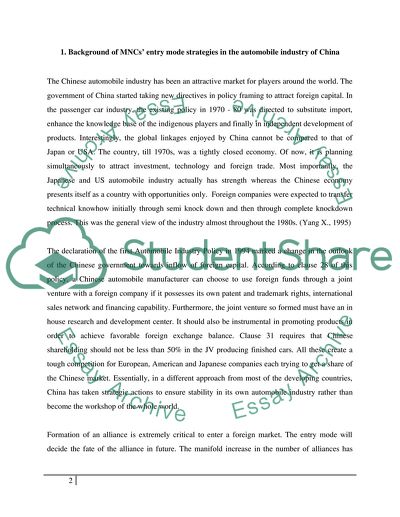Cite this document
(“Toyota Motors Corporation in the Different Aspects of the Chinese Research Paper”, n.d.)
Toyota Motors Corporation in the Different Aspects of the Chinese Research Paper. Retrieved from https://studentshare.org/marketing/1722097-market-entry-mode-strategies-of-multinational-corporations-in-the-automobile-industry-of-china-an-analysis-on-decisions-between-joint-venture-and-wholly-owned-subsidiaries-with-particular-reference-to-the-case-of-toyota
Toyota Motors Corporation in the Different Aspects of the Chinese Research Paper. Retrieved from https://studentshare.org/marketing/1722097-market-entry-mode-strategies-of-multinational-corporations-in-the-automobile-industry-of-china-an-analysis-on-decisions-between-joint-venture-and-wholly-owned-subsidiaries-with-particular-reference-to-the-case-of-toyota
(Toyota Motors Corporation in the Different Aspects of the Chinese Research Paper)
Toyota Motors Corporation in the Different Aspects of the Chinese Research Paper. https://studentshare.org/marketing/1722097-market-entry-mode-strategies-of-multinational-corporations-in-the-automobile-industry-of-china-an-analysis-on-decisions-between-joint-venture-and-wholly-owned-subsidiaries-with-particular-reference-to-the-case-of-toyota.
Toyota Motors Corporation in the Different Aspects of the Chinese Research Paper. https://studentshare.org/marketing/1722097-market-entry-mode-strategies-of-multinational-corporations-in-the-automobile-industry-of-china-an-analysis-on-decisions-between-joint-venture-and-wholly-owned-subsidiaries-with-particular-reference-to-the-case-of-toyota.
“Toyota Motors Corporation in the Different Aspects of the Chinese Research Paper”, n.d. https://studentshare.org/marketing/1722097-market-entry-mode-strategies-of-multinational-corporations-in-the-automobile-industry-of-china-an-analysis-on-decisions-between-joint-venture-and-wholly-owned-subsidiaries-with-particular-reference-to-the-case-of-toyota.


